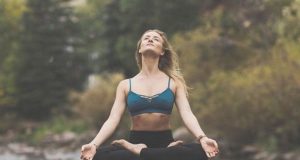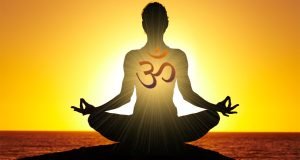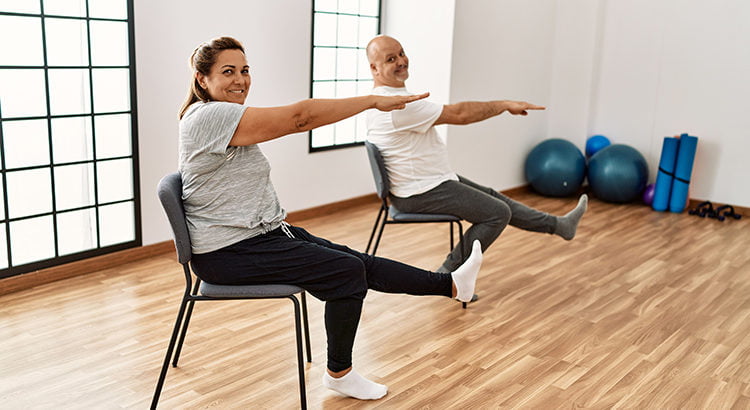
Many elderly persons want to practice yoga poses but can’t do that due to their physical condition. There comes a meditation chair at their rescue. Meditation chair helps elderly persons practice many chair yoga poses with ease.
So, in this article below let’s find out how meditation chairs or stools help seniors practice most chair yoga poses that they wouldn’t have possibly done without a chair.
How Meditation Stool or Chair Is Helpful For Seated Position?
Having the appropriate meditation furnishings are a significant benefit for practitioners who want to feel comfortable with their practice. For those who require more back assistance have physical limitations, or cannot sit peacefully on the floor, an appropriate meditation chair is hugely beneficial.
Be aware that many chairs used for meditation aren’t what we often consider to be chairs. They might resemble seats more. Some are intended to support people who meditate while sitting on the floor, while others are what we may call benches, and yet others are kitchen chairs.
The majority of meditation chairs are portable and light, making it simple to move them anywhere. For instance, floor chairs for meditation are low and incredibly comfortable. Some designs are transportable and simple to move from one location to another, which makes them ideal for travelers who practice meditation.
When you remain in one position for an extended amount of time, pressure gradually accumulates in the back as well as legs. A decent meditation chair removes this pressure. Sitting on a chair promotes proper back alignment in addition to relieving pressure and tension.
Best Chair Yoga Sequence With Meditation Chair
Straight-backed benches or chairs with no backs but comfy seats provide the greatest chairs for meditation. Anyways, here are a few chair yoga poses that you can practice with the help of a meditation stool or chair.
Vrksasana (Tree Pose):
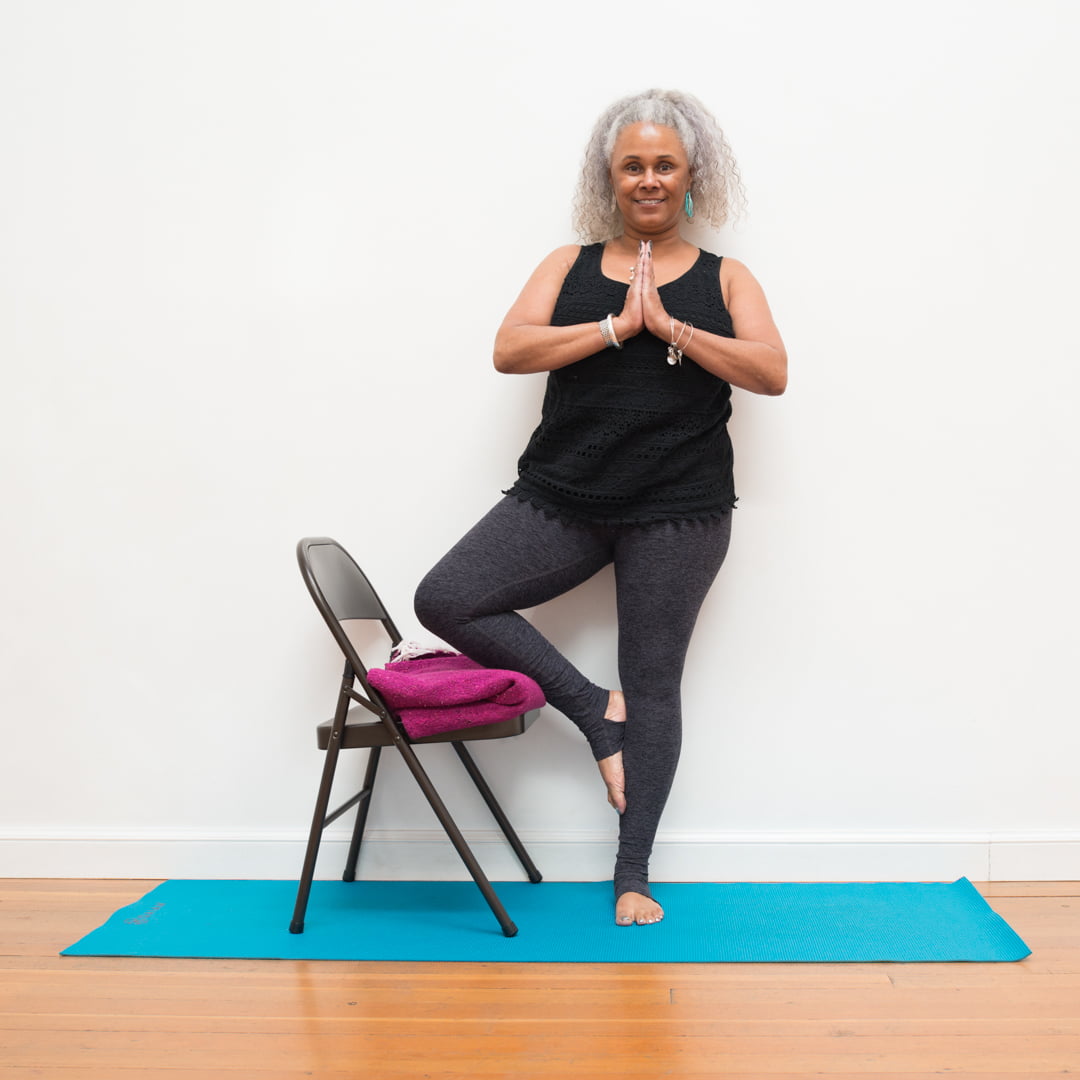
- Orient yourself toward the chair’s front edge. Exhale while pulling your both shoulder blades down the back after taking a deep breath in and elevating your chest. Look steadily forward at a point in the distance.
- Straighten your left leg out in front of you. Point your toes downward or flex your foot.
- While maintaining your right knee bent while your toes or foot is on the ground, extend the right leg out to your side.
- Stretch your arms upwards or make the Anjali Mudra with your hands at your heart.
- Count your breaths. Return to your initial seated position to release the pose. On the opposite side, repeat the position.
Trikonasana (Extended Triangle Pose)
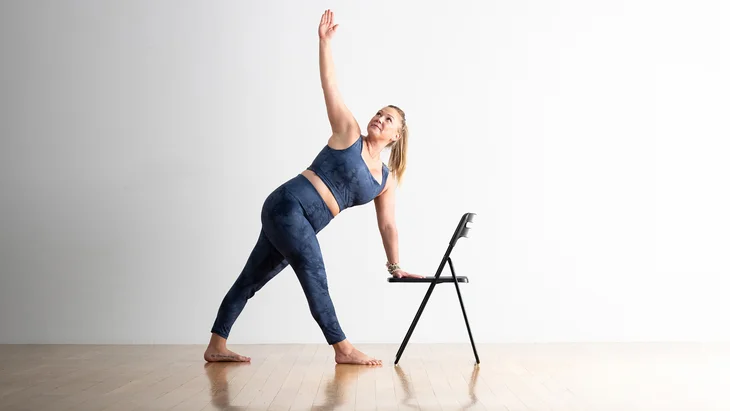
- Your left leg should be able to clear the seat while you sit with your torso on the chair’s left side.
- Straighten out your left leg and place it to the side. Tighten your thigh and extend your leg straight as much as you can.
- Take a deep breath and raise your arms parallel to the ground, straight out from the shoulders. Keep your palms down and your right and left shoulder blades apart.
- After exhaling, slant your torso to your left by bending at the hip. With your left hand on the shin or thigh, extend your left arm out in front of you toward your extended leg. Your right arm should be extended toward the sky.
- Maintain a neutral head position or turn to either look at the right hand or the ground.
- Count your breaths. Take a deep breath and lift your torso, reaching up with the right hand. Bring the left foot back to the middle after that. Repeat the position on the other side by shifting the body to the chair’s right side
Urdhva Hastasana (Upward Salute)
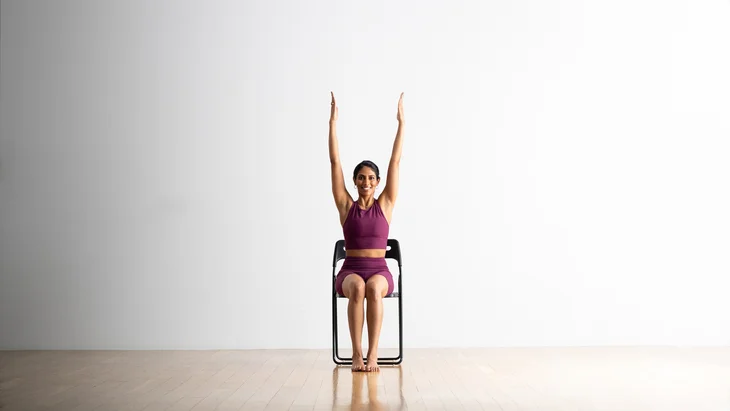
- Place your back slightly away from the back of the chair as you sit down. Lengthen your spine by lifting your head’s crown and letting your tailbone naturally fall into your seat. Put your chin in line with the ground.
- Placing your feet level on the ground with a small gap between your heels and your big toes touching is best.
- Practice with the feet hip-distance apart if you have lower back pain. If your feet don’t reach the floor, put them on blocks.) With your heels, the outside borders of your feet, and big-toe mounds, dig down.
- After taking a deep breath, raise the arms overhead with the hands shoulder-distance apart as well as palms facing each other. You should also pull your shoulders back and soften your front ribcage.
- Reach up to touch the palms, then look at your thumbs if you can maintain your arms straight. Take your arms wider than the shoulders if your shoulders are tight.
- Count your breaths. Downshift your arms.
Utthita Parsvakonasana (Extended Side Angle Pose)
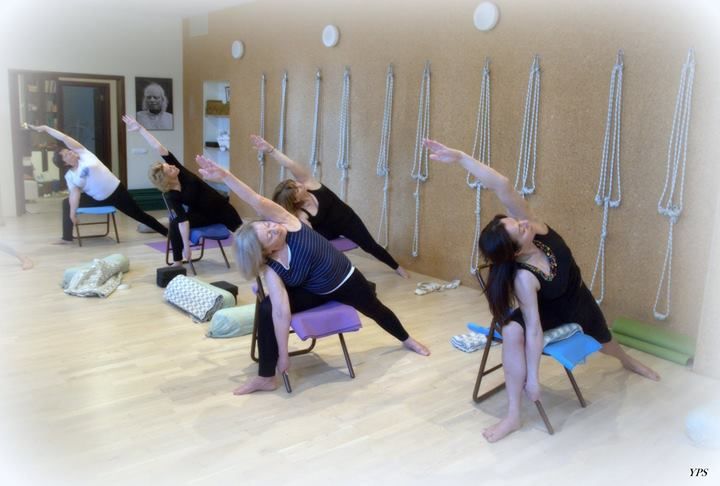
- Face your chair’s left side so that the thighs are completely supported by the seat. Move to the right so that your right leg is clear of the seat by moving toward the front side of the chair.
- Back up with your right leg. Your hips should be wide open facing the chair’s front. Your right foot should be on the ground with your toes pointed forward as you straighten your right leg.
- As you slant your hips to bring your left arm nearer the floor, lean the torso toward the left knee. So that your left arm and shin are parallel, place the left fingertips on a block or the ground.
- Your right arm should be extended toward the sky. Bend the right elbow and then reach back to grab the chair’s back, or extend it across your right ear with your palm facing the ground.
- Turn your torso so that your chest faces the top of your arm. As you stare up at the ceiling, turn your head.
- Breathe in deeply. Release the pose by pushing up with the left hand and bringing your right leg in to sit back down.
- Repeat the position on the opposite side, facing the chair’s right side.
Seated Neck Stretch:
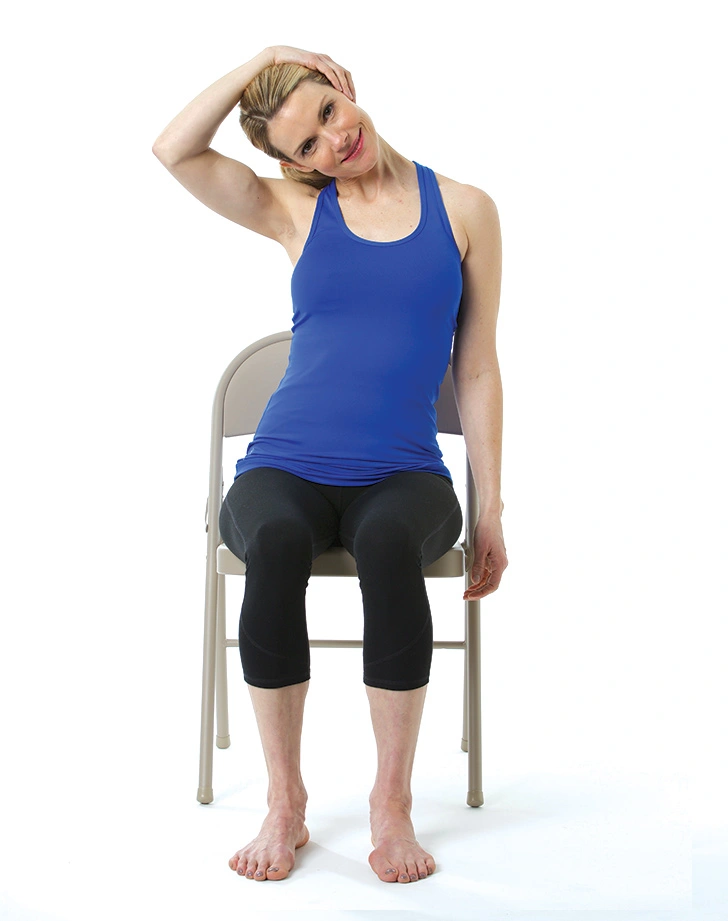
- One of the easiest chair yoga poses, to begin with, is a seated neck stretch.
- This is a great one-time yoga stretch to perform at your desk, particularly after spending a lot of time seated.
- It improves flexibility by releasing tension in the neck while increasing suppleness in the neck’s cervical region.
- Sit up straight and bring the right ear to the right shoulder to perform this stretch. Stay here if this generates enough commotion.
- Otherwise, apply light pressure with your right palm over your left ear to deepen the stretch. Continue on your left side after holding for five to ten breaths.
Seated Bend Forward Pose (Chair Forward Bend):
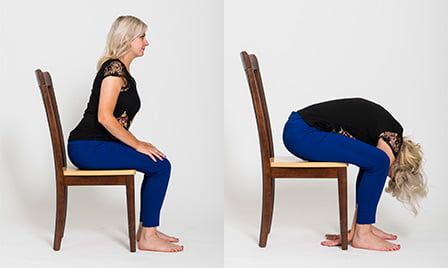
- Lean forward and position yourself two arm’s length from your workstation. Put your heels under your knees and your feet flat on the ground at a hip distance.
- Roll your shoulders back and down as you inhale so they are away from your ears and raise your arms from the side to the sky.
- Look up at your hands.
- Leaning forward or bending forward from the waist over the legs while maintaining a straight spine and long arms requires a controlled exhalation.
- Your head should droop loosely and heavily between your legs, and you should let your hands rest on the ground.
King Arthur’s Pose:
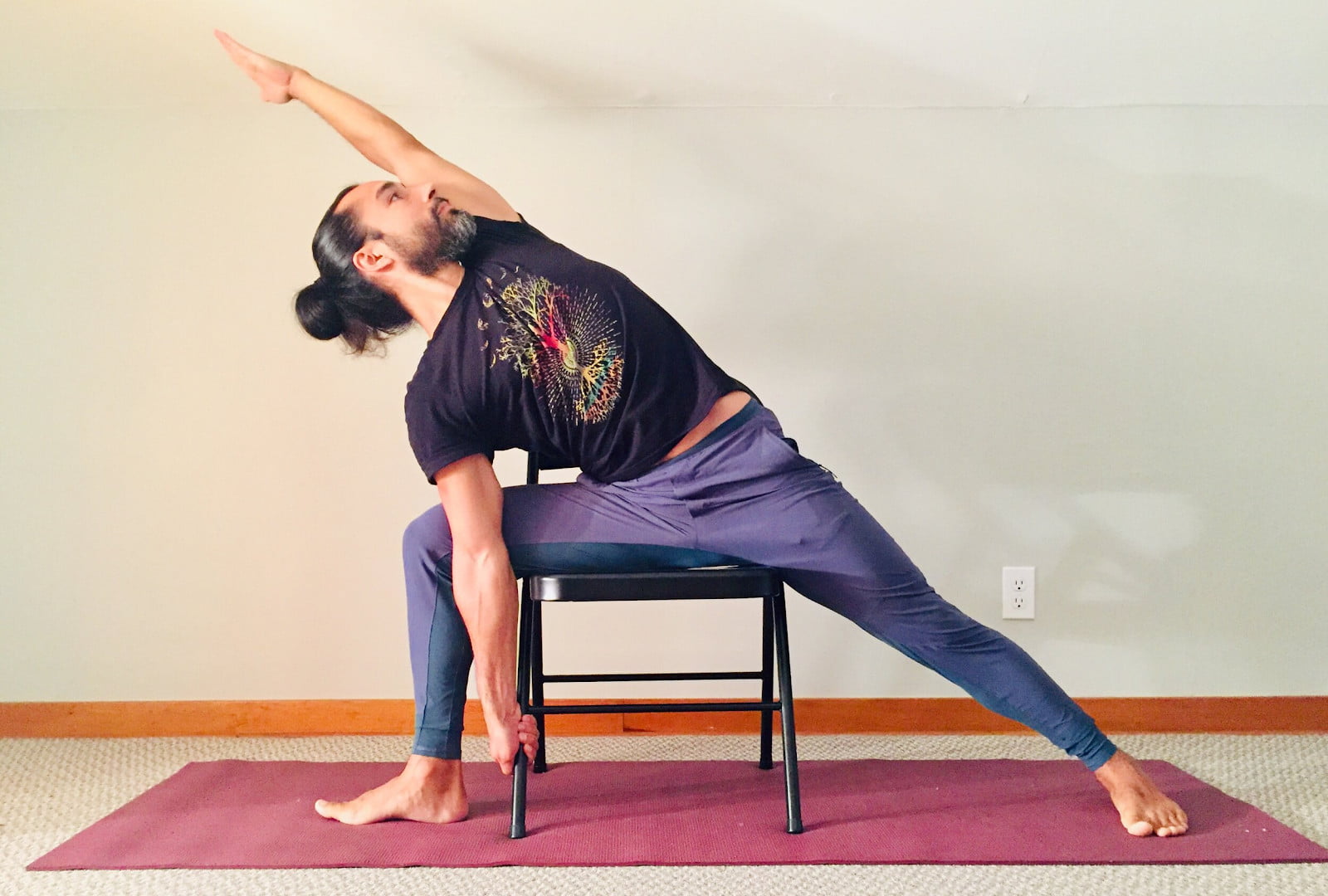
- Place your sit bones approximately midway down the seat of the chair. Place the feet flat on the floor and your knees hip-width apart. Shift your weight to the right side of the seat.
- As you bend your right knee, lift your right foot off the floor, and point the toes toward the back of the chair, keep your right thigh firmly planted on the chair seat.
- Grab your ankle with the right hand as you extend it downward. Lift it gently toward the body until you notice a noticeable stretch in your front shin and quadriceps. (If you’re unable to reach your ankle, wrap your foot in a strap or towel.)
- Inhale three to five times. Return to your original seated position by lowering your foot. On the other side, repeat.
Bitilasana (Cow Pose):
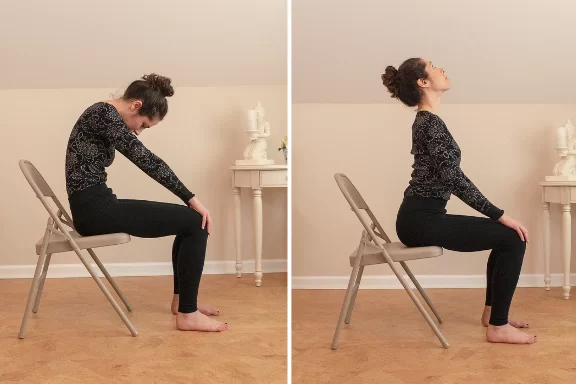
- Your feet & knees should be hip-width apart as you sit in the chair. Your hands should be on your knees.
- Back arches when you inhale. Make a long, even curve by lengthening around the lower back and the back of your neck.
- Broaden your collarbones, lift your sternum and chin, and let your shoulders drop back & away from the ears.
- Count your breaths. Regain a neutral spine position.
Chair Pigeon – Eka Pada Rajakapotasana:
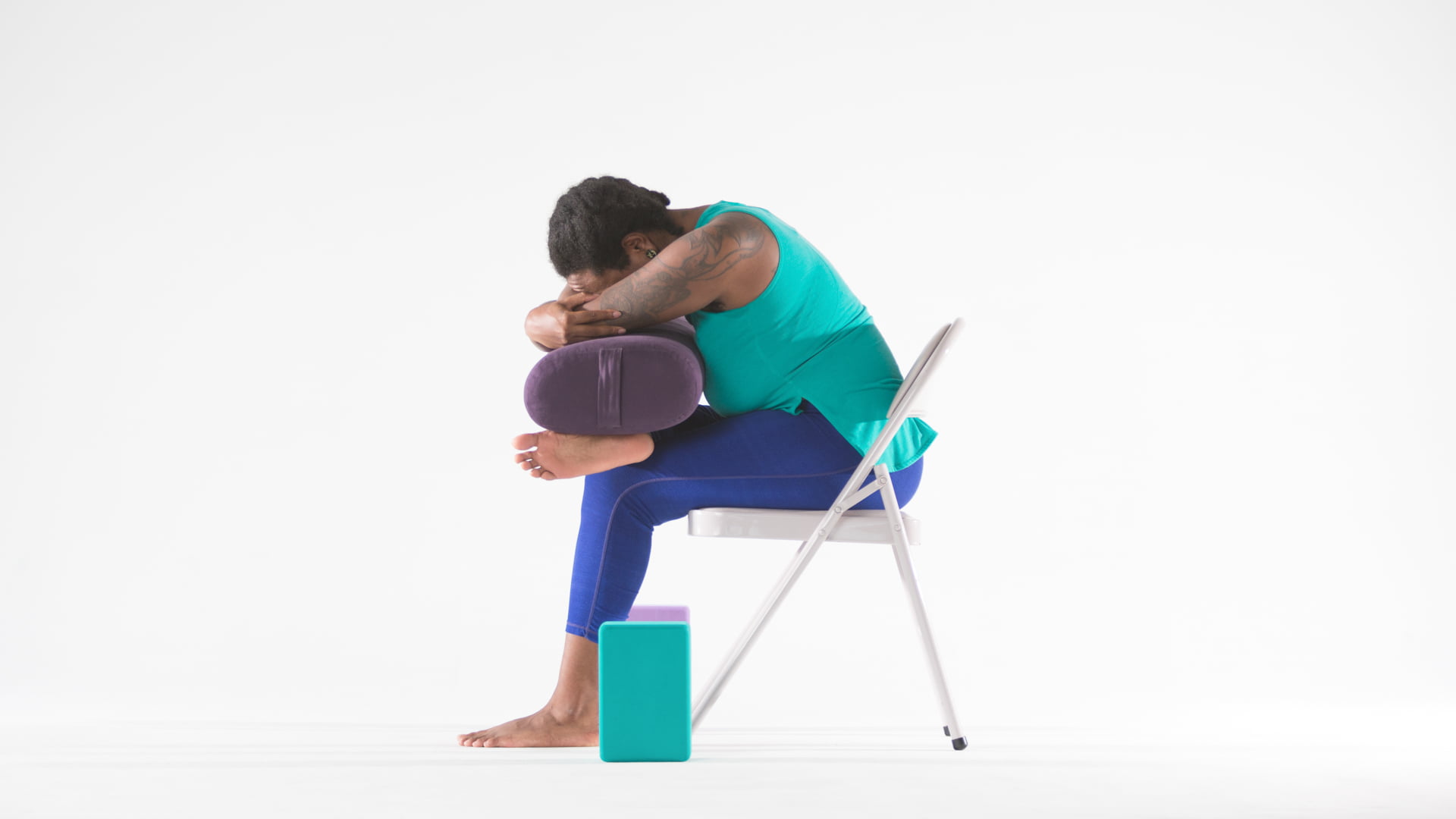
- Sit on a chair straight
- Keep the knee as close to the ankle as you can while bringing the right ankle to rest on the left thigh.
- Hold for 3 to 5 breaths while doing the chair pigeon.
- If you’d like, you can bend forward to make the stretch more intense.
- Continue with the left leg next.
Chair Warrior 2:
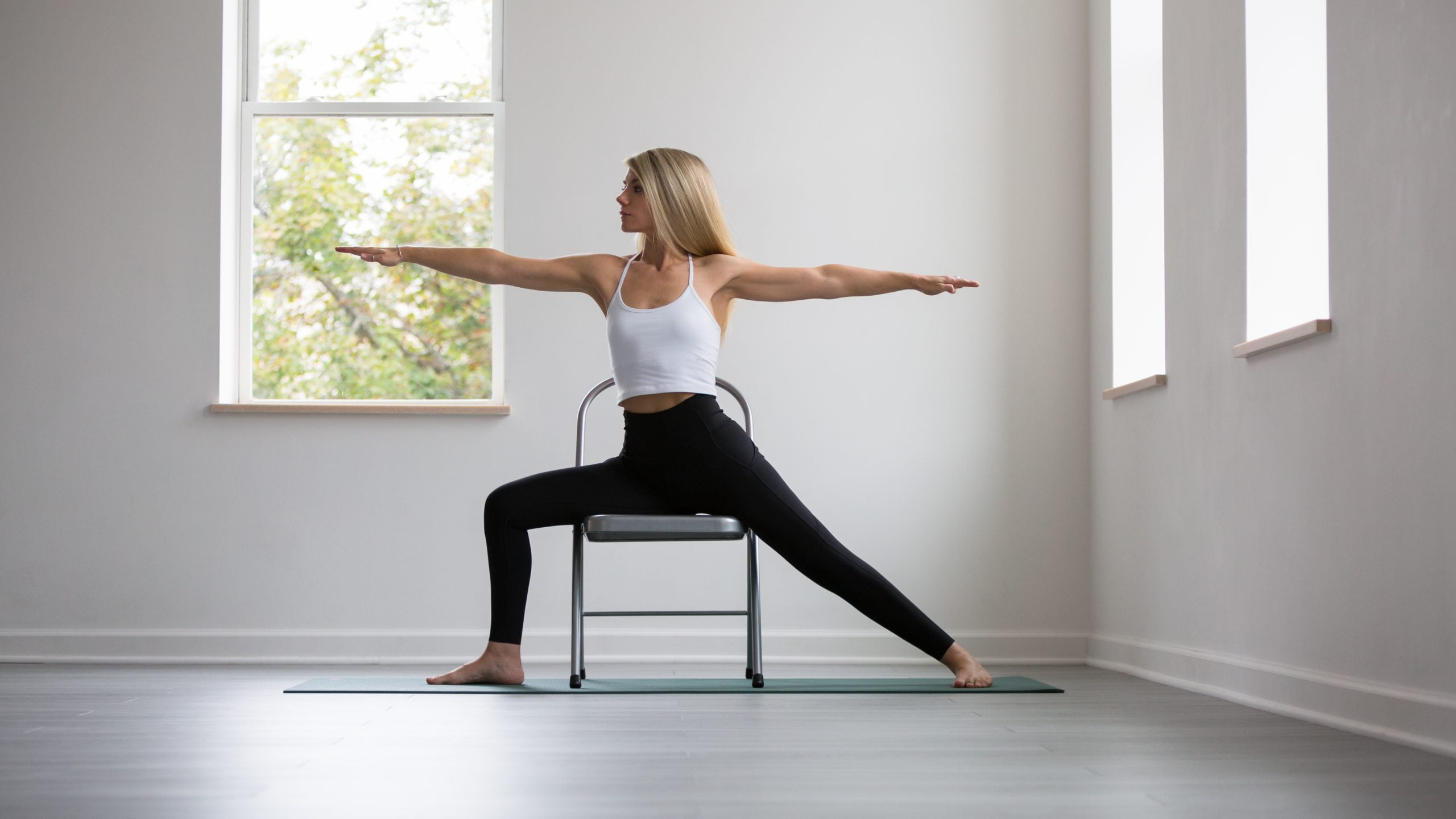
- Sit up straight and go to the front end of your seat.
- The sole of your right foot should be on the ground while you flex the right knee to the side.
- Put your left leg behind you and apply pressure via the outside heel.
- Look at your right hand as you straighten your arms until they are parallel to your shoulders.
- After holding for five breaths, switch to the other side and repeat.
Baddha Konasana (Bound Angle Pose):
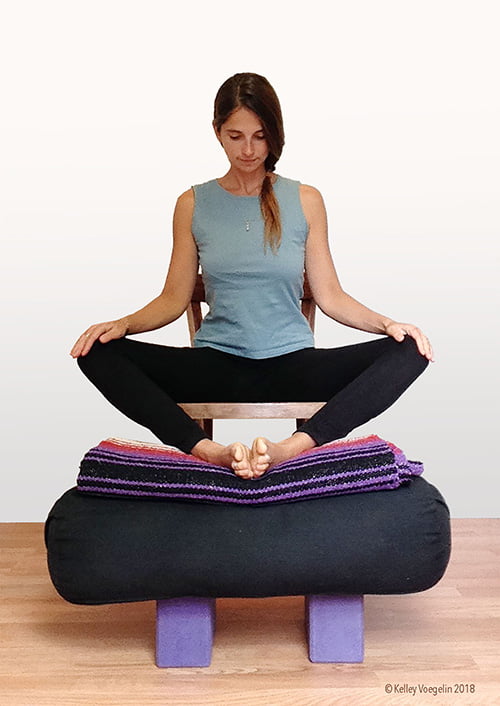
- Your buttocks should be supported but the knees should clear the seat when you sit on the chair.
- Your knees should be facing away from one another when you spread your legs widely.
- To raise through your sternum, sit up straight and push your shoulder blades firmly on your upper back. Your head’s crown should be raised toward the ceiling.
- As you draw your feet together, keep your knees wide. Keep the outside borders of the feet together as you spread them apart like book pages.
- Your thighs should be softly pushed apart by your hands resting on them.
- Count your breaths. Regain your previous seated position by slowly exhaling.
Marichyasana 3:
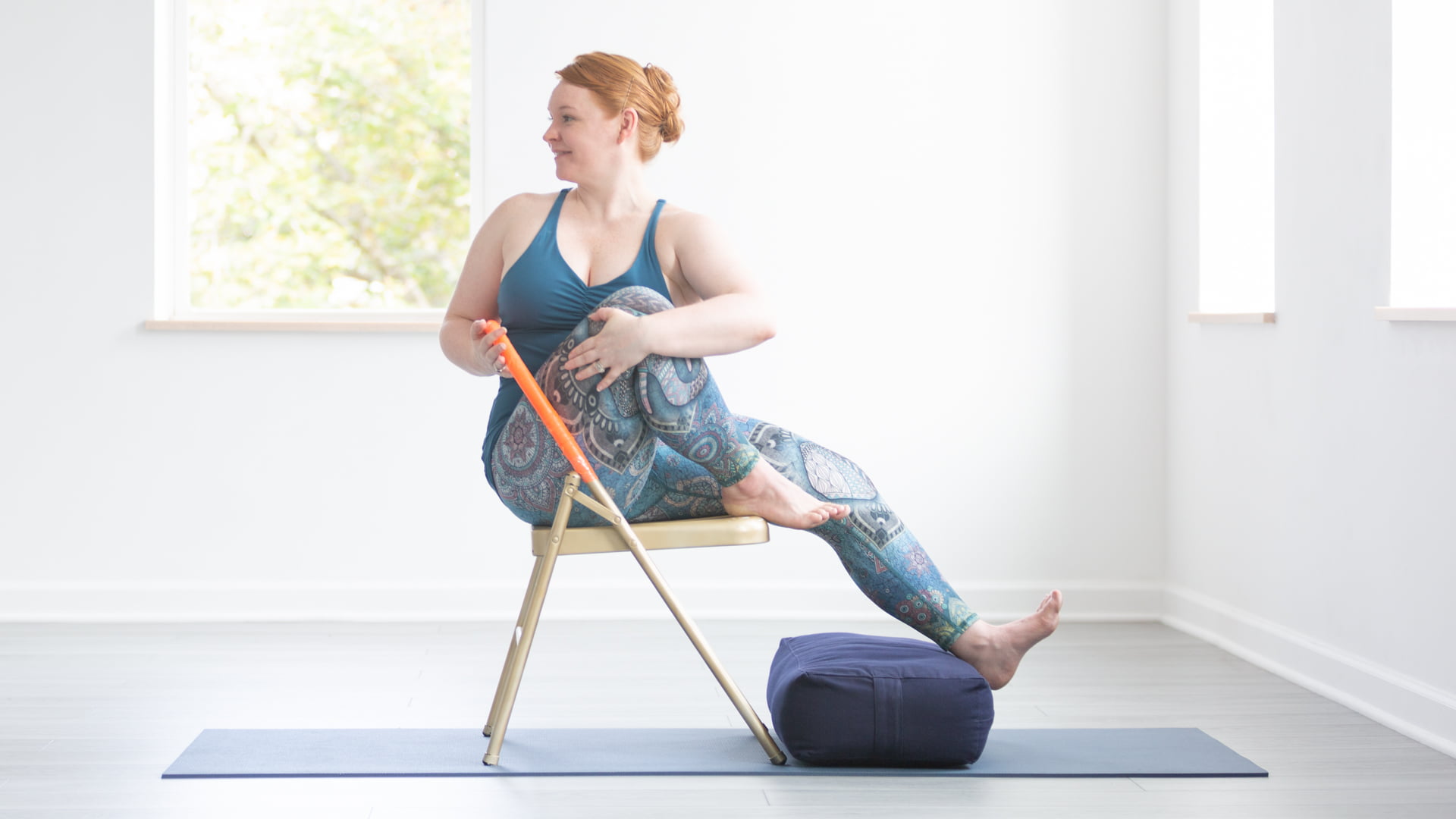
- Ensure that the chair’s back is supporting your spine as you sit. Letting your tailbone naturally drop toward the seat, lengthen your spine.
- Put your feet hip-width apart on the ground.
- Draw your right knee toward the chest as you raise it. As closely as possible to your right sitting bone, place the right foot on the chair’s seat.
- Expand your spine as you inhale. As you exhale, turn to the right. Take hold of the right knee with the left hand or encircle it with your left elbow.
- Place the right arm over the back of the chair and clasp your hands or grab the back of the chair.
- Count your breaths. With each inhalation, lengthen, and with each expiration, gently twist a little bit further.
- Lower your arms, uncurl your torso, and put the right foot back on the floor to exit the pose. On the opposite side, repeat.
BOTTOM LINE:
Good posture promotes awareness and keeps us grounded with proper physical and mental health. The most crucial thing to remember is to keep your spine as erect as it is comfortably as possible because proper spinal alignment during practice encourages optimal energy flow.
Next, you shouldn’t abuse your knees or back! If you choose a chair, make sure it fits you well depending on your height, weight, and comfort level in the back.
FAQ:
Q. Is Chair Yoga Good for You?
A. For seniors, regular exercise is one of the best ways to achieve a healthy lifestyle. Unlike high-impact exercise like running, lifting weights, and plyometrics, chair yoga is easy on your joints, and may serve as a gateway to other forms of exercise.
Q. Are meditation chairs good for you?
A. with a calming forward bend, which lets blood flow to the brain.
Q. What is a meditation chair?
A. A meditation chair is a tool that helps you sit comfortably while practicing meditation.
Q. Is Pipersong legit?
A. even though it is formally advertised as a meditation chair, the majority of the reviews indicate that users—like me—typically use it as an office chair. But it’s also great for meditation, and it’s simple to get comfy and sit there for a while.
Q. Are meditation chairs good for posture?
A. The purpose of meditation chairs is to provide you with both physical and mental support when practicing meditation. To be calm enough to concentrate on your practice, Randhawa claims that meditation chairs can assist you in maintaining your posture.
Also Read:


